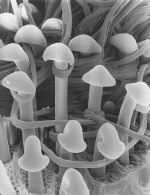Monarch Butterfly Migration Update: April 22, 2005
Today's Report Includes:
- Latest Migration Map and Data
- Migration Animation: Week-by-week Slideshow
- Discussion of C.Q. #11: Which Pattern Best Matches the Migration?
- Ms. Monarch: A Symbol of Her Generation, Nearing its End
- Earth Day: A Good Time to Consider Monarchs
- Monarch Butterfly Life Cycle: What is a Generation?
- Mystery Monarch Adaptation: What is This?
- Challenge Question #14
- Tracking the Migration: Three Simple Methods for Young Students
| News
From Along the Migration Trail |
 |
Migration
Animation: Week-by-week Slideshow
|
 |
| Slideshow |
Discussion of C.Q. #11: Which Pattern Best Matches the Migration?
Students across the map, from New Jersey, New Hampshire, West Virginia, and Arkansas, came together to analyze these migration patterns:
| Migration Patterns |
|||
 |
 |
||
| A |
B |
C | D |
- They chose Patterns A and D. Click here to see their reasons.
Which pattern do you think the migration matches best? How has the pattern changed in the two weeks since they made their analysis?
Ms. Monarch: A Symbol of Her Generation, Nearing its End
"Boy did I have a surprise this morning. Ms. Monarch is still alive!!!" wrote an ecstatic Dr. Edson from Arkansas. "When I checked on her yesterday she was lying on her side on the bottom of her cage. I thought she was dead. I picked her up, moved her wings around, and misted her with some water, all with no apparent movement. When I came in this morning she was upright and on the other end of the cage. I misted her again and took her outside in the sunshine for a couple of hours. I don't know if that helped, but she is still moving around a little. She wouldn't take any nectar, so I don't think she will last much longer. But maybe she will make it until Earth Day on Friday."
Ms. Monarch's story ends the tale of her generation, now in the last days of life. Earth Day is a fitting time to consider monarchs, and how dependent they are on good habitat. Few monarchs are alive in late April; we depend on the earth to deliver the next generation, and their miraculous cycle of life to continue.
"Generation One isn't far from hitting the airwaves!" announced Carol Cullar from Eagle Pass, Texas. "Another 3 days should see some really fresh monarchs headed out of here."
Eggs laid as the monarchs arrive in Texas each spring are the first to become adults of the next generation. Most likely, today's map shows how far the monarchs from Mexico will travel this spring. Let's see how the map changes in the next weeks, as the new generation follows in the wake of their parents.
Monarch Butterfly Life Cycle: What is a Generation?
The monarch butterfly changes from egg, to larva, to chrysalis, and to adult during its life cycle. Each complete cycle is called a generation. A monarch generation takes about one month. How long are the generations of other animals Journey North tracks? How long are human generations? Do some research. Then compare the length of generations of various species and of the families in your class.
 |
 |
 |
 |
| Egg | Larva | Chrysalis | Adult |
| Monarch Life Cycle | |||
Mystery Monarch Adaptation: What is This?
 |
| Dr. Lincoln Brower, Sweet Briar College |
This is a picture of part of a monarch butterfly. It is magnified 180 times. What do you suppose it is? Here are some clues:
- A monarch has this body part only during the two weeks the monarch needs it.
- The tall things that look like mushrooms are caught in the stuff that looks like spaghetti.
- This is an example of a "physical adaptation." (A physical adaptation is part of an organism's body that helps it survive in its environment.)
Challenge Question #14
"What part of a monarch butterfly do you think the picture shows? With your answer, explain how this body part helps the monarch survive."(To respond to this question, please follow the instructions below.)
Tracking the Migration: Three Simple Methods for Young Students
Challenge young students to make predictions as they watch the butterflies spread throughout their northern breeding range. Have them form a hypothesis as to why the monarchs travel where they do. Try these mapping methods, alone or in combination, with young students. Have them:
- Color each state/province when the first monarch arrives, according to the legend.
- Mark the date on each state/province when the first monarch arrives.
- Label each state/province according to the order in which the first monarch arrives.
 |
||
| Color |
Mark dates |
Label Order |
Link to blank map for student-use
How to Respond to Today's Monarch Challenge Question
1. Address an e-mail message to: jn-challenge-monarch@learner.org
2. In the Subject Line of your message write: Challenge Question #14
3. In the body of your message, answer the question above.
The Next Monarch Migration Update Will Be Posted on April 29, 2005
Copyright 2005 Journey North. All Rights Reserved.
Please send all questions, comments, and suggestions to our
feedback form












